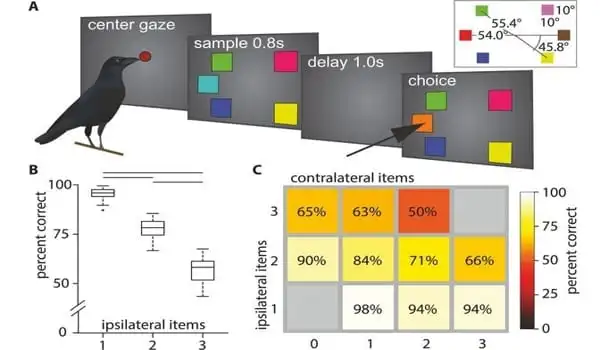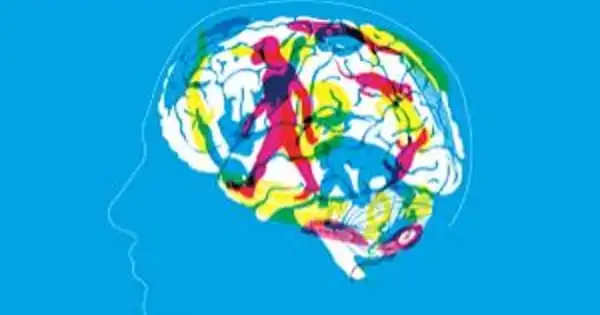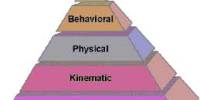The neural networks in the brains of birds and humans are very different. Nonetheless, similar mechanisms limit their working memory. Some of the similarities between birds and humans can be attributed to the fact that they shared a common ancestor millions of years ago. That ancestor was a primitive, reptile-like creature that didn’t look like a human or a bird but shared characteristics with both.
Working memory is the brain’s ability to process information in a retrievable state for a short period of time. It is required for complex cognitive tasks such as thinking, planning, following instructions, and problem-solving. A team of Ruhr-Universität Bochum (RUB) researchers has now succeeded in delving deeper into this special area of memory in birds and comparing it to data storage in the mammalian brain. Despite their different brain architectures, birds and monkeys share the same central mechanisms and working memory limits, according to the researchers.
The researchers from the Neural Basis of Learning department at RUB have published the results in the journal eLife.
The working memory capacity of some birds, such as crows, is similar to that of humans, despite the fact that their brain architecture is very different from that of mammals. We wanted to know how brains with such obvious structural differences could produce working memories with comparable capacities.
Professor Jonas Rose
We humans rely on our neocortex—the part of the brain that comprises the majority of the cerebral hemispheres—for the majority of higher cognitive processes, such as abstract thinking, problem-solving, memory formation, and complex communication. The neocortex is also involved in the expression of our emotions and personalities. The neocortex is not unique to humans. All primates, and indeed all mammals, have one, albeit none as large and complex as ours. Scientists have traditionally regarded the human neocortex as evolution’s pinnacle achievement, but they are now discovering that evolution has resulted in some extremely intelligent brains with no neocortex at all.
Birds’ tiny brains lack a neocortex, and their structures and connections differ from those of primates. This is not surprising given that birds diverged from the line of evolution that led to mammals and then to humans via primates more than 200 million years ago. What is surprising is that, despite the lack of a neocortex, birds can perform complex cognitive tasks that were previously thought to be unique to primates and, in some cases, humans. These tasks include seeing optical illusions, forming concepts, comprehending another person’s mental state, using and manufacturing tools, and communicating specific meanings to achieve specific goals. These discoveries challenge our notion of the evolution of the brain and show us that there is more than one way of wiring an intelligent brain.

Research on the bird brain complements existing models
Working memory capacity is limited. Humans can only process about four pieces of information at once, and it was this limitation that piqued the Bochum researchers’ interest. “There are various theories about how limitation occurs in the brain and what role the network of neurons plays in this,” first author Lukas Hahn explains. “However, existing models are solely based on research in humans and other primates. We wanted to add our expertise to these.”
Hahn, who works at the Faculty of Psychology in Professor Jonas Rose’s department, specializes in studying the neuronal basis of cognition in the avian brain. “The working memory capacity of some birds, such as crows, is similar to that of humans, despite the fact that their brain architecture is very different from that of mammals,” says Jonas Rose, head of RUB’s Neural Basis of Learning department. “We wanted to know how brains with such obvious structural differences could produce working memories with comparable capacities.”
Test design transferred from macaque monkeys to carrion crows
To accomplish this, the Bochum scientists observed crows at the Bochum Faculty of Psychology. They put the birds’ working memory to the test using an exercise designed for macaque monkeys. “We taught the crows to memorize a different number of colored squares on a screen,” Hahn explains. “After a one-second pause with a black screen, we showed them the squares on the screen again, but slightly different. The birds had been tasked with determining which square had changed.”
The scientists recorded neuron activity in an area of the brain corresponding to the prefrontal cortex – the central hub of cognition in mammals – while the crows performed the task. “The studies showed that the neurons in the crows’ brains responded to changing colors in virtually the same way that the neurons in monkeys did,” Rose explains. Furthermore, the scientists discovered that increasing the number of items the crows had to remember had the same effect on the amount of information individual neurons encoded as had previously been observed in monkeys.
Same mechanisms despite different brain architecture
Mr. Lukas Hahn: “The similarities between the distantly related bird and mammalian species validate previously held core beliefs about the limits of working memory. Furthermore, they suggest that despite their different brain architecture, birds and apes share the same core mechanisms and limits of working memory.” And Hahn already has plans for a follow-up project, which will look into how different regions of the birds’ brains interact with each other when processing working memory signals. “That would be an exciting future question to uncover more neural bases of cognition in the avian brain,” he says.
















